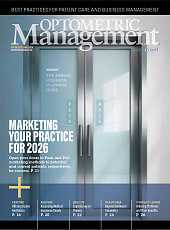HUMAN ADENOVIRUSES (HAdVs) are non-enveloped, double-stranded DNA viruses known for their resistance to environmental conditions and disinfectants (Russell, 2009). They are extremely resistant to environmental desiccation, staying infectious for extended periods on various surfaces, including metal, plastic, and eye drop bottles (Gordon et al, 1993; Nauheim et al, 1990; Uchio et al, 2002). As non-enveloped viruses, HAdVs exhibit resistance to myriad disinfectants due to the structural properties of their capsid proteins (Uchio et al, 2002) and can spread through both direct and indirect transmission, causing a wide range of infectious diseases (Russell, 2009; Miro et al, 2021; Jonas et al, 2020).
Up to 75% of all acute conjunctivitis cases are due to HAdVs (Labib et al, 2020). Epidemic keratoconjunctivitis (EKC), pharyngoconjunctival fever, and isolated follicular conjunctivitis are the most typical ocular presentations of conjunctivitis (Labib et al, 2020; Angueyra et al, 2021).
EKC is an extremely contagious infection affecting the conjunctiva and cornea, with the potential to cause vision impairment (Jonas et al, 2020). It is commonly linked to nosocomial (under medical care) outbreaks and spreads easily in populous settings, including schools, nursing homes, and swimming pools (Angueyra et al, 2021; Hall et al, 2010; Ghebremedhin, 2014; Esparcia Rodriguez et al, 2020).
At least 19 serotypes of adenovirus can cause EKC (Lourenco Nogueira, 2025). The most common serotypes associated with EKC are serotypes 8, 19, and 37 (Lourenco Nogueira, 2025). Although less common, serotype 5 has been linked to EKC and pharyngoconjunctival fever (Jhanji et al, 2015; Shieh, 2022). The impact of adenovirus on the cornea and vision can be severe, causing infiltrates and light sensitivity, with a risk of transmission via multiuse contact lenses (CLs) (Uçakhan and Yanik, 2016; Garcia-Zalisnak et al, 2018).
There is a paucity of data about the efficacy of CL care products against HAdVs. One study investigated the antiviral activity of 6 commercially available CL care solutions against human adenovirus type 5 (Ad5) (Nogueira et al, 2025).
Quantitative suspension tests were performed on Ad5 solutions following interaction with various CL care solutions for 4 or 6 hours (Nogueira et al, 2025). Additionally, interaction times of 0, 2, 4, and 6 hours before neutralization were analyzed for the hydrogen peroxide (H202) solution. Lastly, the effect of rubbing and rinsing of CLs contaminated with Ad5 with the solutions was evaluated.
Povidone iodine solutions displayed greater than 3-log reduction of the virus after 4 and 6 hours of incubation (Nogueira et al, 2025). Povidone iodine solutions significantly reduced the viability of Ad5.
After 6 hours of incubation with H202 solution, a 0.52-log reduction was demonstrated. Extending the contact time with H202 increased Ad5 inactivation, resulting in a 2.18-log reduction after 6 hours of incubation with the solution before neutralization. H202 care solutions are more efficacious if the unneutralized contact time is increased.
Nonoxidative (multipurpose solutions [MPS]) systems did not show a substantial log reduction after 4 hours of incubation. Rubbing and rinsing CLs with MPS systems effectively reduced the virus counts on contaminated lenses to less than the limit of quantification. Thus, MPS systems can effectively combat contaminated lenses only when a rub-and-rinse step is included.
This study validated that quantitative suspension tests indicate that products containing povidone iodine exhibit significantly greater disinfection efficacy compared to the other evaluated care products. Unexpectedly, 3% H202 was not effective against Ad5, even when the manufacturer’s instructions were followed. Various CL materials, including hydrogel, silicone hydrogel, and rigid lenses, were similarly susceptible to Ad5 contamination, which could be effectively removed by rubbing or rinsing the lens surfaces with saline alone. In addition, the effectiveness of CL care products using MPS disinfection systems against Ad5 can be enhanced by incorporating a rub-and-rinse step before overnight disinfection.
This highlights the importance of adhering to proper disinfection protocols to eliminate infectious HAdVs from lens surfaces.
References
1. Russell WC. Adenoviruses: update on structure and function. J Gen Virol. 2009;90:1-20. doi: 10.1099/vir.0.003087-0
2. Gordon YJ, Gordon RY, Romanowski E, Araullo-Crux TP. Prolonged recovery of desiccated adenoviral serotypes 5, 8, and 19 from plastic and metal surfaces in vitro. Ophthalmology. 1993;100:1835-1839. doi: 10.1016/s0161-6420(93)31389-8
3. Nauheim RC, Romanowski EG, Araullo-Cruz T, et al. Prolonged recoverability of desiccated adenovirus type 19 from various surfaces. Ophthalmology. 1990;97:1450-1453. doi: 10.1016/s0161-6420(90)32389-8
4. Uchio E, Ishiko H, Aoki K, et al. Adenovirus detected by polymerase chain reaction in multidose eyedrop bottles used by patients with adenoviral keratoconjunctivitis. Am J Ophthalmol. 2002;134:618-619. doi: 10.1016/s0002-9394(02)01599-4
5. Miro E, Del Cuerpo M, Rubio M, et al. Whole-genome analysis to describe a human adenovirus d8 conjunctivitis outbreak in a tertiary hospital. J Med Virol. 2021;93:4840-4845. doi: 10.1002/jmv.26850
6. Jonas RA, Ung L, Rajaiya J, et al. Mystery eye: Human adenovirus and the enigma of epidemic keratoconjunctivitis. Prog Retin Eye Res. 2020;76:100826. doi: 10.1016/j.preteyeres.2019.100826
7. Ismail AM, Cui T, Dommaraju K, et al. Genomic analysis of a large set of currently- and historically-important human adenovirus pathogens. Emerg Microbes Infect. 2018;7:10. doi: 10.1038/s41426-017-0004-y
8. Labib BA, Minhas BK, Chigbu DI. Management of adenoviral keratoconjunctivitis: Challenges and solutions. Clin Ophthalmol. 2020;14:837-852. doi: 10.2147/OPTH.S207976
9. Angueyra MF, Marcone DN, Escarra F, et al. Direct costs and clinical impact of adenovirus genotype 8 conjunctivitis outbreak in a neonatology unit. Infect Control Hosp Epidemiol. 2021;42:142-148. doi: 10.1017/ice.2020.404
10. Hall K, Blair Zajdel ME, Blair GE. Unity and diversity in the human adenoviruses: Exploiting alternative entry pathways for gene therapy. Biochem J. 2010;431:321-336. doi: 10.1042/BJ20100766
11. Ghebremedhin B. Human adenovirus: Viral pathogen with increasing importance. Eur J Microbiol Immunol (Bp). 2014;4:26-33. doi: 10.1556/EuJMI.4.2014.1.2
12. Esparcia Rodriguez O, Gomez Martinez A, Martinez Nieto MJ, et al. [Outbreak of epidemic keratoconjunctivitis caused by human adenovirus serotype 8 in a nursing home][article in Spanish]. Rev Esp Salud Publica. 2020;94:e202009100.
13. Lourenco Nogueira CL, Boegel SJ, Shukla M, et al. Antiviral activity of contact lens care solutions and rub-and-rinse regimen against adenovirus. Optom Vis Sci. 2025 Feb 5 [Online ahead of print] doi: 10.1097/OPX.0000000000002231
14. Jhanji V, Chan TC, Li EY, Agarwal K, Vajpayee RB. Adenoviral keratoconjunctivitis. Surv Ophthalmol. 2015;60:435-443. doi: 10.1016/j.survophthal.2015.04.001
15. Shieh WJ. Human adenovirus infections in pediatric population—An update on clinico-pathologic correlation. Biom J. 2022;45:38-49. doi: 10.1016/j.bj.2021.08.009
16. Uçakhan Ö, Yanik Ö. The Use of Bandage Contact Lenses in Adenoviral Keratoconjunctivitis. Eye Contact Lens. 2016;42:388-391. doi: 10.1097/ICL.0000000000000206
17. Garcia-Zalisnak D, Rapuano C, Sheppard JD, Davis AR. Adenovirus ocular infections: Prevalence, pathology, pitfalls, and practical pointers. Eye Contact Lens. 2018;44(Suppl 1):S1-S7. doi: 10.1097/ICL.0000000000000226




